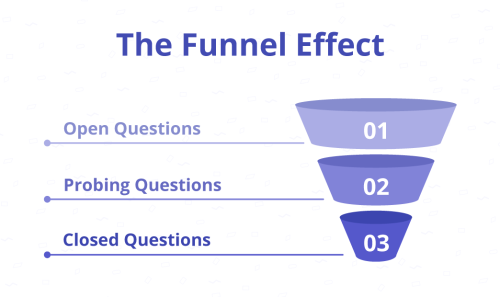The Top 12 Helpful Probing Questions for Customer Service Agents

When a contact center agent answers a customer’s call, they never know what they will get on the other end. Being prepared with probing questions will help the agent take the call to a satisfactory resolution and improve their CSAT score. Not all callers are knowledgeable about their issue and able to explain it well. Some require the agent to pull key details out of them. That’s where probing questions come in.
What is a probing question?
Whether it’s Oprah, Howard Stern, or Anderson Cooper, the most effective interviewers use probing questions. The best practice for extracting information is to ask plenty of questions that cannot be answered with a simple yes or no. Most probing questions require a fuller answer. However, yes/no questions can also probe when they’re used strategically.
A probing question requests more details or further clarification. It requires asking the person to expand on their original statement and go deeper into the heart of a matter. The aim is to gather enough data to inform the best way forward to fix the problem accurately and quickly.
Asking these questions also prevents bias from sneaking in and leading to making assumptions before gathering all the data.
However, these inquiries must be posed thoughtfully, or they can do more damage than good to customer relations. For example, asking why is not recommended unless it’s used to clarify. Asking why can imply blame, as if the caller is responsible for the problem. They’re not the expert, so they’ve called one. Agents must make an effort to avoid putting callers on the defensive. Doing so will inevitably create friction.
Why are probing questions important in customer service?
Probing questions keep the conversation going and shift the focus from problem to solution. Excellent customer service demands that the onus for solving a challenge must transfer to the contact center agent. This way, the customer feels the relief of handing the burden over.
Empathy in customer service plays a significant role in creating that sense of support. So does patience, allowing the customer to explain the situation and pinpointing what’s needed to resolve it. However, probing questions help to lead the conversation toward the information that agents need to reach that resolution.
Having one source of truth that’s immediately accessible to agents instills confidence. Procedureflow, a cloud-based Knowledge Management solution, can make it easier for your customer service professionals to simply follow the process flow to assist customers. So, your team can spend less time trying to figure out process info and more time focusing on fulfilling customer needs.
Four types of probing questions in customer service
Probing questions in customer service fall into four broad categories.
- Leading questions: These are designed to take the conversation to a predetermined place. For example, when trying to upsell or cross-sell products and services: What product/service/features are most important to you?
- Confirming questions: In some cases, this is as simple as repeating the customer’s information back to them and asking whether you understood them correctly. This helps make the customer feel valued and heard.
- Exploratory/Open questions: These questions encourage the caller to expand on their original explanation. When did (problem) begin? Can you tell me more about it?
- Funnel questions: This category of probing questions is meant to move the conversation from general information (the top of the funnel) to specifics (the bottom of the funnel) so you can hone in on the issue.
Funnel questions

Let’s dive a little deeper into Funnel Questions.
As you can see, the funnel effect begins with Exploratory/Open Questions. To answer, the caller must give details in a free-form way. These questions cannot be answered with a simple yes or a no. They’re used to gather initial details.
In the center are Probing Questions. Use these when answers to Exploratory Questions aren’t drilling down to the core of the issue.
At the bottom of the funnel are Closed Questions. This is where a range of choices is offered, and the caller must choose one. Example: “I have three spots open for a technician visit on that date. Which one would you like?”
This funnel is an excellent outline for extracting information that leads to a successful outcome. But, as the great rock band 38 Special once sang, “Hold on Loosely.” It’s not carved in granite. There will be times when sprinkling in a variety of types of queries is proper before the bottom of the funnel is reached and a resolution is achieved.
When should you ask a probing question?
Whenever you need more detailed information, probing questions should be introduced when:
- The customer isn’t explaining the issue fully and you need specifics.
- You want to get to—and past—the customer’s emotions. For example, to figure out the impact on the customer. And to focus a clearly frustrated customer on the fact that you will solve their problem once you understand it.
- You want to build rapport.
Deciding how and when to use probing questions is a skill that contact center agents can develop. With the help of Procedureflow, employees are able to access the right information, at the right time, and in any location. This means customer needs are put first and addressed in the most professional and cost-effective manner possible.
The top 12 probing questions in customer service
Variations on the following list of questions may apply, depending on the product or service offered.
- What was your main reason for calling us today? (Particularly helpful if the caller has a list of complaints or demands.)
- Could you give me an example?
- How long has this been an issue?
- When did you first notice the problem?
- Has this happened before?
- What have you already done to try to solve the issue?
- What effect has this had on you?
- Can we circle back to …? (If the customer skips an important detail that needs revisiting.)
- Can you provide a bit more detail on that?
- When you say … what do you mean?
- What is your ideal outcome from calling today?
- Is there anything else I can help you with today?
For quicker resolution of customer service issues, make probing questions part of your agents’ toolkit. To find out how Procedureflow can help your employees reach proficiency faster, book a demo today.
Written by Lisa Brandt.


